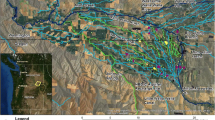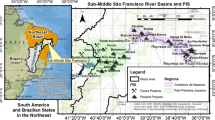Abstract
Structural and operational management methods are used to meet water demands in watersheds around the world. Most river systems are affected by reservoirs, dams, or other engineering structures, and decisions regarding their construction and operation are made in advance of knowing what water demands will be. Numerical models are used to predict future water needs and evaluate the effectiveness of water management strategies. It is important to consider a variety of management methods and future environmental conditions to ensure future demands can be met. In this work, a coupled surface water operations and hydrologic model of the Lower Republican River Basin in portions of Nebraska and Kansas, USA is used to evaluate the ability of several water management strategies, including structural and operational, to meet future demands of a water-stressed agricultural basin under a variety of future climate scenarios. Simulations indicate recent administrative and operational changes to the distribution of water between Nebraska and Kansas have significantly decreased water shortages for irrigation districts in Kansas and will continue to do so. Simulations also indicate that structural alternative of reservoir expansion is most effective at minimizing shortages to demands under a repeat of historical climate conditions. However, an operational alternative of increasing water supplies for Kansas' exclusive use, such as those historically purchased under the Warren Act (US Code 43 Section 523–524), is most effective at minimizing shortages to demands under a hotter and drier climate, demonstrating how optimal water management strategies can vary significantly depending upon climate scenario.







Similar content being viewed by others
References
Brookfield, A.E., and Wilson, B.B. (2015). Integrated groundwater/surface water model for the lower republican river basin, Kansas: A Progress Report. Kansas Geological Survey Open-File Report 2015–2011, 27 pp.
Christensen, F.D. (2004). Coupling Between the River Basin Management Model (MIKE BASIN) and the 3D Hydrological Model (MIKE SHE) with the Use of the OpenMI System. In Hydroinformatics 2004: Proceedings of the 6th international conference on hydroinformatics, Singapore, June 21–24, 2004. Published by World Scientific.
Condon LE, Maxwell RM (2014a) Feedbacks between managed irrigation and water availability: diagnosing temporal and spatial patterns using an integrated hydrologic model. Water Resour Res 50(3):260–266
Condon, L.E., and Maxwell, R.M. (2014b). Groundwater-fed irrigation impacts spatially distributed temporal scaling behavior of the natural system: a spatio-temporal framework for understanding water management impacts. Environmental Research Letters, Vol. 9, No. 3.
Dunlap, L.E. (1982). Geohydrology of principal aquifers in the Republican River basin, Kansas. USGS Open-File Report 1982–0079, 5 over-size sheets.
Ferguson, I.M. (2015). Climate Change Analysis for the Republican River Basin Study. US Bureau of Reclamation Technical Memorandum No. 86-68210-2015-07, 109 pp.
Helsel, D.R. and Hirsch, R.M. (2002). Statistical Methods in Water Resources. From: Techniques of Water-Resources Investigations of the United States Geological Survey, Book 4, Hydrologic Analysis and Interpretation, Chapter A3, 524 pp. http://pubs.usgs.gov/twri/twri4a3/pdf/twri4a3-new.pdf
HydroLogics (2009). OASIS with OCL, Model Version 3.10.8, GUI version 4.6.16. 339 pp.
KBID Annual Report (2010). 11 pp. http://dwr.kda.ks.gov/20111028_KBID_Production/Number%2011,12 %20&%2014/Annual%20Report/KBID%20000570%20ANNUAL%20REPORT%202010.pdf
Kracman D (2015) Draft Nebraska modeling results for RRBS project. Internal Memo
Meehl, G.A., Covey, C., Delworth, T., Latif, M., McAvaney, B., Mitchell, J.F.B., Stouffer, R.J., and Tayler, K.E. (2007). The WCRP CMIP3 multi-model dataset: a new era in climate change research. Bulleting of the American meteorological society, Vol 88 p 1383–1394.
Nebraska and Kansas, 2005. Lower Republican River Basin Appraisal Report. http://www.usbr.gov/gp/nkao/fext050121final.pdf
Perkins SP, Sophocleous MA (1997) Lower republican stream-aquifer project, final report; volume 2, development and documentation of a combined watershed and stream-aquifer modeling program. KGS Open-File Report 97-9:164p
PRISM Climate Group, (2014). Oregon State University, http://prism.oregonstate.edu, created May 2014.
Republican River Compact Administration (2003). Republican River Compact Administration Ground Water Model, June 30, 2003. http://www.republicanrivercompact.org/v12p/RRCAModelDocumentation.pdf
Sophocleous, M.S., Perkins, S.P., Stadnyk, N.G., and Kaushal, R.S. (1997). Lower republican stream-aquifer project: final report. KGS Open-File Report 97-8, 131 p.
State of Nebraska, Department of Natural Resources (2010). Integrated Management Plan Jointly Developed by the Department of Natural Resources and the Upper Republican Natural Resources District. http://www.urnrd.org/sites/default/files/files/1/integratedmanagementplan.pdf
Szilagyi, J. (2001). Identifying the cause of declining flows in the republican river. Journal of water resources planning and management, Vol. 127 pp 244–253.
Therrien R, McLaren RG, Sudicky EA, Panday SM (2010) HydroGeoSphere: a three-dimensional numerical model describing fully-integrated subsurface and surface flow and solute transport. University of Waterloo, Waterloo, Ontario, Canada, Groundwater Simulations Group
U.S. Department of Agriculture Agricultural Research Service (2005). ROSETTA class average hydraulic parameters: http://www.ars.usda/gov/Services/docs.htm?docid8955. Accessed December, 2012.
Valerio A, Rajaram H, Zagona E (2010) Incorporating groundwater-surface water interaction into river management models. Ground Water 48(5):661–673
Wang W-C, Chau K-W, Xu D-M, Chen X-Y (2015) Improving forecasting accuracy of annual runoff time series using ARIMA based on EEMD decomposition. Water Resour Manag 29:2655–2675
Author information
Authors and Affiliations
Corresponding author
Rights and permissions
About this article
Cite this article
Brookfield, A.E., Gnau, C. Optimizing Water Management for Irrigation Under Climate Uncertainty: Evaluating Operational and Structural Alternatives in the Lower Republican River Basin, Kansas, USA. Water Resour Manage 30, 607–622 (2016). https://doi.org/10.1007/s11269-015-1180-y
Received:
Accepted:
Published:
Issue Date:
DOI: https://doi.org/10.1007/s11269-015-1180-y




